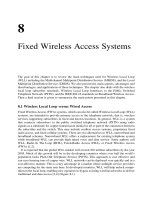Fixed Wireless Access Systems
Bạn đang xem bản rút gọn của tài liệu. Xem và tải ngay bản đầy đủ của tài liệu tại đây (195.72 KB, 10 trang )
8
Fixed Wireless Access Systems
The goal of this chapter is to review the main techniques used for Wireless Local Loop
(WLL) including the Multichannel Multipoint Distribution Service (MMDS), and the Local
Multipoint Distribution Service (LMDS). We also present the main aspects, advantages and
disadvantages, and applications of these techniques. The chapter also deals with the wireless
local loop subscriber terminals, Wireless Local Loop Interfaces to the Public Switched
Telephone Network (PSTN), and the IEEE 802.16 standards on Broadband Wireless Access.
Then a final section is given to summarize the main points presented in this chapter.
8.1 Wireless Local Loop versus Wired Access
Fixed Wireless Access (FWA) systems, which can also be called Wireless Local Loop (WLL)
systems, are intended to provide primary access to the telephone network; that is, wireless
services supporting subscribers in fixed and known locations. In general, WLL is a system
that connects subscribers to the public switched telephone network (PSTN) using radio
signals as a substitute for copper transmission media for all or part of the connection between
the subscriber and the switch. This may include cordless access systems, proprietary fixed
radio access, and fixed cellular systems. There are two alternatives to WLL: narrowband and
broadband schemes. Narrowband WLL offers a replacement for existing telephone system
while broadband WLL can provide high speed voice and data service. Some authors call
WLL, Radio In The Loop (RITL), Fixed-Radio Access (FRA), or Fixed Wireless Access
(FWA) [1,2].
It is expected that the global WLL market will exceed 202 million subscribers by the year
2005. Much of this growth will be in the developing countries where over half the world’s
population lacks Plain Old Telephone Service (POTS). This approach is cost effective and
can save burying tons of copper wire. WLL networks can be deployed very quickly and in a
cost-effective manner. This is a key advantage in a market where multiple service providers
are competing for the same user base. In developed countries, WLL will help unlock compe-
tition in the local loop, enabling new operators to bypass existing wireline networks to deliver
traditional and data access [3,4] (Figure 8.1).
WLL systems have a number of advantages over wired systems to subscriber local loop
support. Among these are [1–10]:
†
Time of installation. The time required to install a WLL system is much less than that for a
wired system. The major issues are having a permission to use a given frequency band and
finding an elevated site for the base station antenna. Once these issues are resolved, a WLL
system can be installed very quickly.
†
Cost. Despite the fact that the electronics of a wireless transceiver is more expensive that
for a wired system, overall total cost of wireless system components, installation, and
maintenance is less than for a wired system.
†
Scale of installation. In WLL, radio transceivers are installed only for those subscribers
who need the service at a given time. In wired systems, a cable is usually laid out in
anticipation to serve an entire block or area.
The communications regulatory commissions in most countries have set aside frequency
bands for use in commercial fixed wireless service. For example, the Federal Communica-
tions Commission (FCC) in the United States has set aside fifteen frequency bands for use in
this application.
Many WLL systems are based on Personal Communication Systems (PCS) or cellular
technology. These PCS or cellular technologies can be analog such as AMPS, TACS, and
ETACS, or digital such as GSM, DECT, PDC, CDMA, W-CDMA, and CDMA2000. WLL
systems based on such technologies can benefit from the associated economies of scale as
well as the reduced costs. There are specific characteristics of fixed wireless systems that are
not fully addressed by mobile wireless technologies without explicit consideration. While
mobile technologies can readily be used for WLL systems, the ideal WLL system for a given
market will be designed and adapted for fixed rather than mobile services. The major distinc-
tions between mobile and fixed technologies are very clear from the WLL network deploy-
ment, the WLL subscriber terminals, and the WLL interface to the PSTN.
Due to the fact that the subscriber locations in a WLL system are fixed and not mobile, the
initial deployment of radio base stations need only provide coverage to areas where immedi-
Wireless Networks230
Figure 8.1 A wireless local loop configuration
ate demand for service is apparent. Service for a town or city, for example, can begin area by
area as the WLL base stations are deployed. This distinction between mobile and fixed
applications does not in itself imply much difference in the technology, but other dissimila-
rities associated with network deployment do. It is important to note that the capacity needed
for a WLL system is different from that for a fixed WLL system. A mobile system’s base
stations must provide adequate capacity to support worst-case traffic, while a fixed system’s
base stations must only provide the capacity needed to support a known number of subscri-
bers. In a fixed system, the Quality of Service (QoS) may need to be better, and the traffic
generated per subscriber may be higher due to lower charging rates than those for premium
mobile service and the different usage patterns of homes and offices. Therefore, the ideal fixed
WLL system should be fully scaleable and modular in order to be able to add any necessary
additional capacity to the base stations. This allows the redistribution of additional capacities
among existing base stations. Also, this means that base stations can be redeployed as needed
in order to meet new demands in traffic. There is also a difference in the nature of coverage of
WLL and wired access loop applications. While in the former applications a mobile system
must effectively provide communications to all areas within signal range of the base station, a
wired access system can assume that the subscriber terminal has been positioned to obtain the
best possible signal.
In a fixed subscriber environment, a terminal is oriented for the greatest signal strength
upon installation, and, if needed, a directional antenna pointing to the nearest WLL base
station can be used to improve the signal quality in terms of the carrier-to-interference ratio or
range extension. Furthermore, a fixed subscriber terminal will not experience the same
magnitude of fading effects seen by a mobile terminal.
Due to the differences between fixed and mobile propagation environments, the transmit
power levels of a fixed WLL system can be reduced compared to that of a mobile system,
assuming the same range of coverage and all other variables hold constant. Directional
antennas may be used at the base station to further improve the system’s link margins if
the fixed subscribers are localized [5–7].
8.2 Wireless Local Loop
In this section, we look at the main characteristics of the two well-known types of wireless
local loop techniques: the Multichannel Multipoint Distribution Service (MMDS), and the
Local Multipoint Distribution Service (LMDS).
8.2.1 Multichannel Multipoint Distribution Service (MMDS)
In the United States, the FCC has allocated five frequency bands in the range of 2.15–2.68
GHz for fixed wireless access using the Multichannel Multipoint Distribution Service
(MMDS). Table 8.1 shows the fixed wireless communication bands that have been allocated
by FCC.
The first two bands were licensed in the 1970s for TV broadcasting and they were then
called Multipoint Distribution Services (MDSs). In 1996, the FCC increased the allocation
and allowed for Multichannel Multipoint Distribution Services (MMDS). This new service
has become a strong competitor to cable TV providers for offering services in rural and
Fixed Wireless Access Systems 231
remote areas that cannot be reached by broadcast or cable TV. It is due to this specific
application that MMDS is also called wireless cable.
The FCC does not allow the transmitted power of the base station of an MMDS to service
an area beyond 50 km. The subscriber antennas of the transmitter and receiver must be in the
line of sight. The main advantages of MMDS, over the Local Multipoint Distribution Service
(LMDS) are [2,3,7]:
†
Due to the fact that equipment operating at lower frequencies is less expensive, the cost of
the subscriber and base station is lowered.
†
Since the wavelengths of MMDS signals are larger than those for LMDS, MMDS signals
can travel farther without suffering from power losses. This means that MMDS can operate
in considerably larger cells, which lowers the cost of the electronics for base stations.
†
Because MMDS signals have relatively longer wavelengths, they are less susceptible to
rain absorption. Moreover, MMDS signals do not get blocked easily by objects, which
allow them to be sent for longer distances.
The main drawback of MMDS systems compared to LMDS systems is that they offer much
less bandwidth. Due to this drawback, it is expected that MMDS services will be used mainly
for residential subscribers and small businesses [1–6].
8.2.2 Local Multipoint Distribution Service (LMDS)
The Local Multipoint Distribution Service (LMDS) is the broadband wireless technology
used to deliver voice, data, Internet, and video services in the 25 GHz and higher spectrum. It
is considered a relatively new service. Due to the propagation characteristics of signals in this
Wireless Networks232
Table 8.1 Frequency bands allocated by the United States FCC for fixed wireless communications
bands
Frequency range (in GHz) Application
2.150–2.162 Licensed Multichannel Distribution Service (MDS),
2 bands of 6 MHz each
2.4000–2.4835 Unlicensed Industrial, Scientific, and Medical (ISM)
2.596–2.644 Licensed Multichannel Multipoint Distribution Service (MMDS),
8 bands of 6 MHz each
2.650–2.656 Licensed MMDS
2.6620–2.6680 Licensed MMDS
2.6740–2.6800 Licensed MMDS
5.7250–5.8750 Unlicensed National Information Infrastructure (ISM-UNII)
24.000–24.250 Unlicensed ISM
24.250–25.250 Licensed
27.500–28.350 Licensed LMDS/Block A
29.100–29.250 Licensed LMDS/Block A
31.000–31.075 Licensed LMDS/Block B
31.075–31.225 Licensed LMDS/Block A
31.225–31.300 Licensed LMDS/Block B
38.600–40.000 Licensed
frequency range, LMDS systems use a cellular-like network configuration. In the United
States, 1.3 MHz of bandwidth has been allocated for LMDS to deliver broadband services in
point-to-point or point-to-multipoint configurations to residential and commercial customers;
near 30 GHz. In Europe and most developing countries, frequencies near 40 GHz will be used
for this purpose. Table 8.1 depicts the frequency bands that have been allocated by the FCC
for fixed wireless access in the United States including LMDS. Figure 8.2 shows a general
configuration on the Local Multipoint Distribution Service (LMDS).
In LMDS systems, the propagation characteristics of the signals limit the potential cover-
age area to a single cell site. In metropolitan areas, the range of an LMDS transmitter can go
up to 8 km. Signals are transmitted in a point-to-multipoint or broadcast method. The wireless
return path, from subscriber to the base station, is a point-to-point transmission. It is impor-
tant to note that the services offered through an LMDS network are entirely dependent on the
operator’s choice of service.
The main advantages of LMDS systems are [7–10]:
†
It is easy and fast to deploy these systems with little disruption to the environment.
†
As a result of being able to deploy these systems rapidly, realization of revenue is fast.
†
LMDS are relatively less expensive, especially if compared with cable alternatives.
†
Easy and cost-effective network maintenance, management, and operation.
†
Data rate is relatively high, in the Mbps range.
†
Scalable architecture with customer demand, which makes them cost effective.
It is expected that the LMDS services will be a combination of voice, video, and data.
Therefore, both Asynchronous Transfer Mode (ATM) and Internet Protocol (IP) transport
technologies will be practical when viewed within a country’s telecommunications infra-
structure.
The major drawback of LMDS is the short range from the base station, which necessitates
the use of a relatively large number of base stations in order to service a specific area [10].
Fixed Wireless Access Systems 233
Figure 8.2 An example of Local Multipoint Distribution Service (LMDS)









